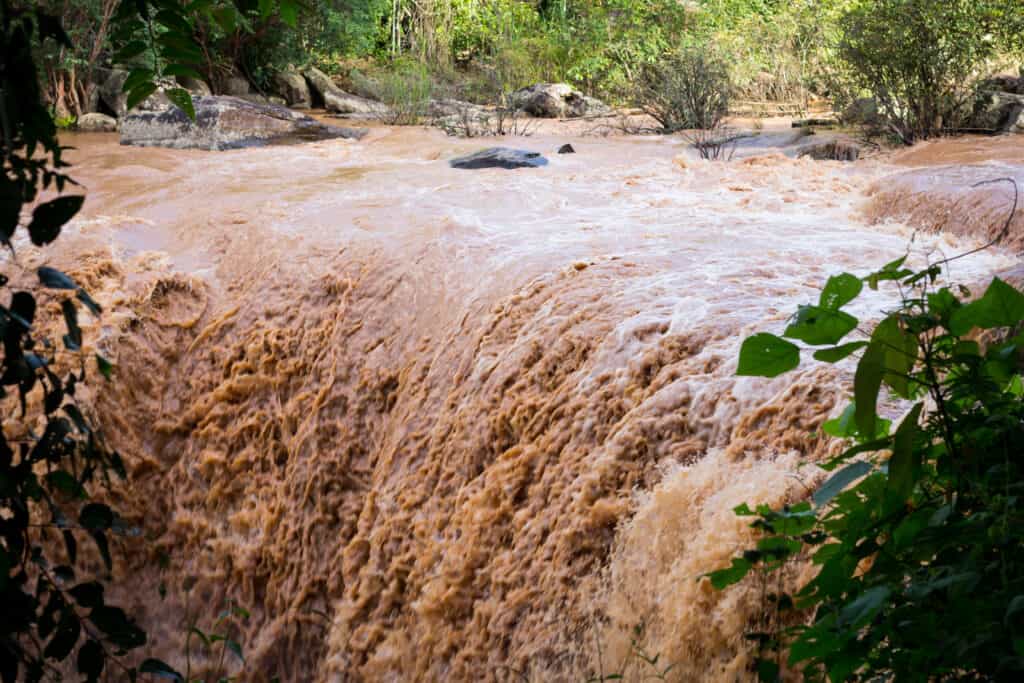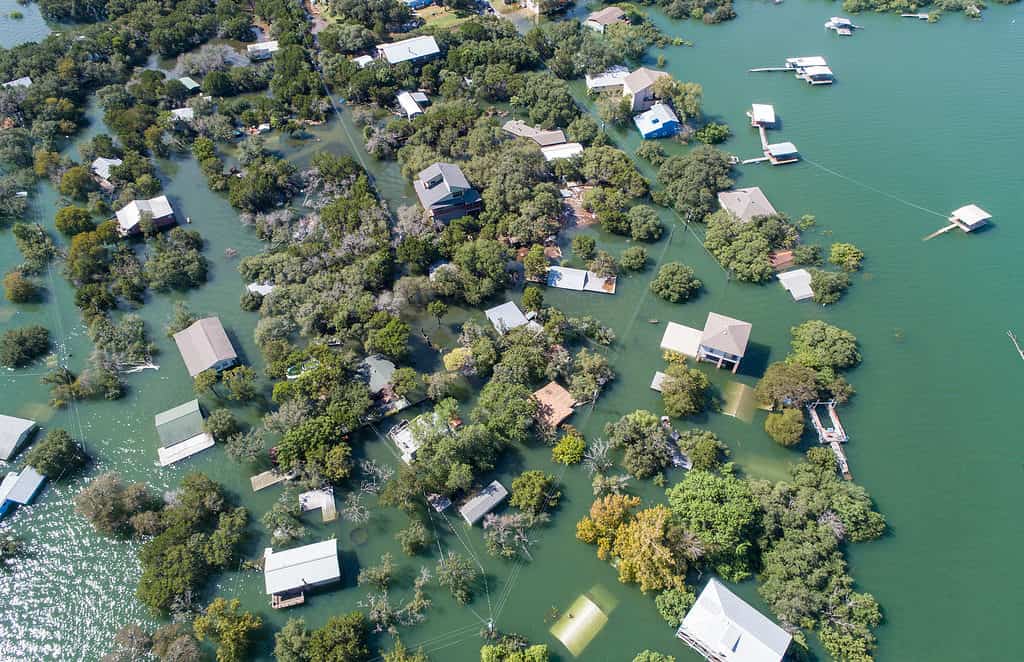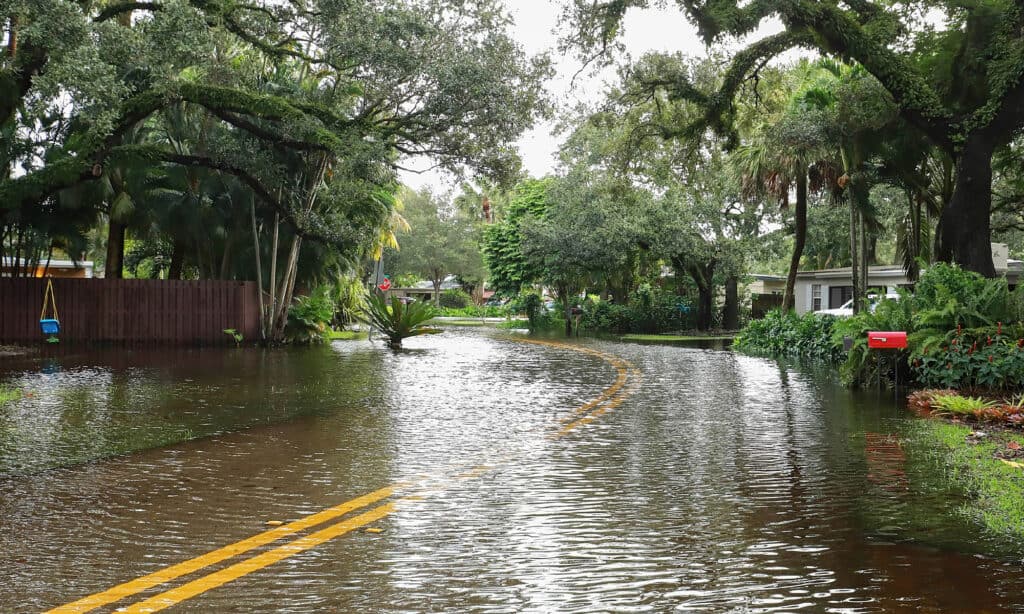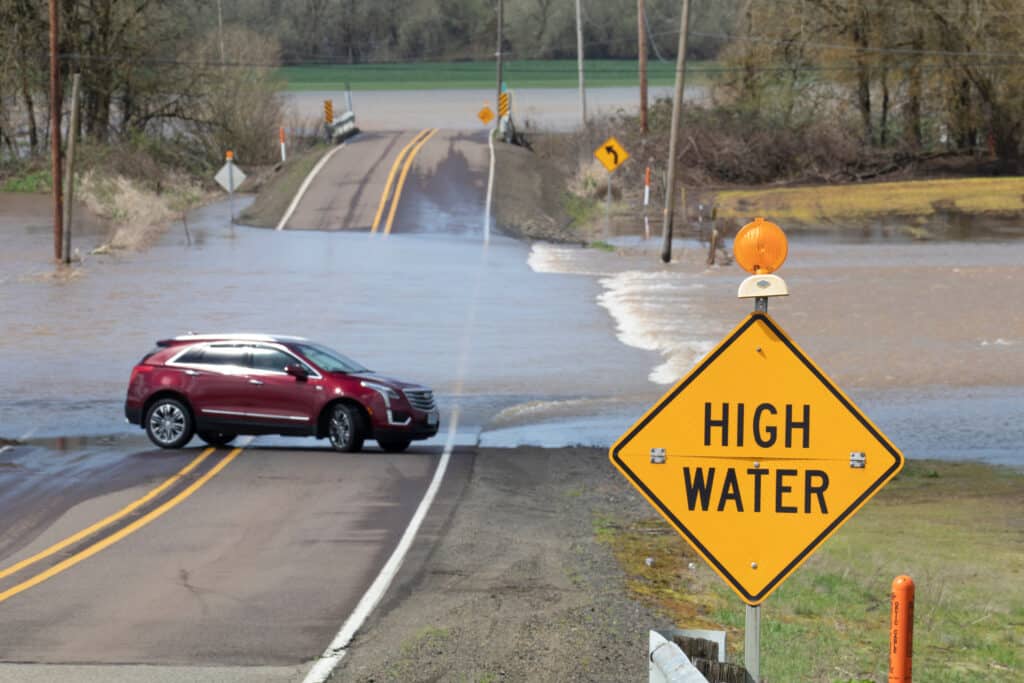Floods are typically the deadliest natural disaster in the United States each year. More Americans die in floods annually than in any other natural event, and flash floods are the most dangerous of all.
Areal floods develop more gradually than flash floods and normally cover a larger area. Flash floods claim more lives, though, due to how rapidly they form.
A flash flood is often violent and can form with astounding speed. Most flash floods are the result of slow-moving or successive storms in a localized area. These flooding events usually form within six hours or less after the rain, although they can sometimes form in mere minutes.

Flash flooding occurs when the ground can’t absorb any more water, causing waterways, drainage ditches, and sewers to overflow.
©jirateep sankote/Shutterstock.com
Watches and Warnings
But what is the difference between a flash flood watch and a warning? We’ve all seen the notices scrolling along the bottom of our TV screens or received a text message informing us of the weather situation in our area. But what do the different notifications mean?
According to the National Weather Service, a flash flood warning is issued when a flash flood is imminent or is currently happening.
A watch is issued when conditions are favorable for a flood to occur. It does not mean flooding will definitely materialize, but all the elements needed to form a flood are present, making it a distinct possibility. An areal flood watch means flooding is possible over a larger area, but a flash flood watch means intense and very rapid flooding is possible in a localized area.
Where Do Flash Floods Occur the Most in the U.S.?
Flash floods can occur everywhere. All 50 U.S. states are at risk, but there are some states where it is more common than others. These four states typically see more flash floods than the rest of the nation.
1. Louisiana
For anyone who remembers the devastation of Hurricane Katrina in 2005, it comes as no surprise that Louisiana would be on this list. But flooding is a risk to Louisianans even when no hurricane is present.
49% of the state lies below sea level, meaning almost half of the state does not naturally drain, even after normal rainfall. Pumps and levee systems are used to move the water. Should those systems fail, the results can be catastrophic.
There are nearly 5,000 miles of rivers, creeks, canals, and bayous in Louisiana. The state is also the second-rainiest in the U.S., trailing only Hawaii. When a state has thousands of miles of waterways and nearly half of the state’s area is below sea level, receiving 60 inches of rain each year is bound to produce abundant flash flooding.

New Orleans’ 17th Street Canal Pump Station forms part of the city’s flood control mechanism.
©iStock.com/sfe-co2
2. Texas
More people die from floods in Texas yearly than in any other U.S. state. There are several factors, one of which is the large population. Texas is the second-most populous state. Only California has more people. It is also the second-largest state in terms of area. Only Alaska is bigger. With so many people populating such a vast expanse of land, the chances of death from flooding just naturally go up. Flooding is the number one cause of weather-related deaths in the state.
But there are other environmental and geographical factors at play, as well. A large swath of central Texas has come to be known as “flash flood alley.”
This infamous alley runs through San Antonio and then curves northward. Cities in its path include New Braunfels, San Marcos, Austin, Temple, Waco, and Dallas.
Central Texas is especially susceptible to flash floods because major storms arrive from the Pacific Ocean and the Gulf of Mexico as well as strong frontal boundaries from the Great Plains. This often produces storms with such torrential rain that the ground cannot absorb it. The water has nowhere else to go but into the nearest stream or creek, causing a flash flood.

Austin lies in the heart of “flash flood alley” in Texas.
©iStock.com/1057751720
3. Florida
Florida is the fifth-rainiest state in the U.S. The state also features thousands of miles of ocean shoreline and over 11,000 miles of rivers and other waterways. All of this water makes Florida one of the most flash-flood-prone states in the nation. With a population well above 22 million, the risk of flooding deaths is high throughout the state.
Cape Coral, Florida, was recently determined to be the most at-risk city for flooding in the United States. The city sits at only five feet above sea level. It was originally a mangrove swamp before it was developed. There are 400 miles of canals throughout Cape Corral, and thousands of residences and buildings have been built along those waterways. As a result, it’s estimated that 70% of the city’s properties are at significant risk of flooding, a higher percentage than anywhere else in the U.S.

Much of Florida is prone to flash floods, as seen here in Fort Lauderdale.
©iStock.com/JillianCain
4. California
California is one of the most drought-prone states in the nation, so it may seem rather odd that it would also see such a large number of flash floods. But California’s drought and flood potentialities are not mutually exclusive.
When an extended drought is in place, the ground is hardened and not easily penetrated by water. As a result, it takes a slow, soaking rain for the moisture to make its way into the soil. But when an intense storm drops a large amount of rain in a short time, the ground cannot absorb the water, and it runs off into the nearest waterway. That waterway soon overflows its banks.
Wildfires also increase water runoff. The charred ground cannot absorb the water, and the vegetation that would normally slow the flow of water has been burned up. This leads to erosion, landslides, and flash flooding. And it all happens in the most populous state in the country. Many Californians often find themselves caught in this vicious cycle of not enough rain, followed by far too much rain all at once.

California’s droughts and wildfires add to its flooding risk.
©Danaan/Shutterstock.com
Flood Safety
Again, it is important to note that flash floods can happen anywhere in the U.S. It’s very simple: if it can rain, it can flood. The four states discussed above may experience more flash floods than most, but these disasters can happen anywhere and during any season.
When a flash flood watch or warning is issued, remember these safety tips.
- Stay away from stream and creek beds, drainage ditches, and culverts. Move from low-lying areas to higher ground.
- Nighttime increases flood dangers. Be alert.
- If your vehicle stalls, leave it and move to higher ground. Flash floods can swallow up vehicles and sweep them away.
- Never drive through standing water. Most flash flood deaths result from people driving their vehicles into flooded waters. You’ve heard it before, but it’s absolutely essential: turn around, don’t drown!
- Children are especially at risk. Never allow children to play in or around flowing water. This is not just true of natural waterways. It also applies to flooded streets and other areas.
Never underestimate the power and unpredictability of a flood. Take action when a flash flood watch or warning is given for your area. These floods can become overwhelming in mere minutes, and waiting too long to act can have tragic consequences.

Turn around, don’t drown!
©Catherine Avilez/Shutterstock.com
The photo featured at the top of this post is © iStock.com/Astrid860
Thank you for reading! Have some feedback for us? Contact the AZ Animals editorial team.






